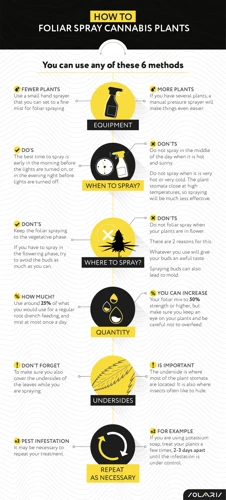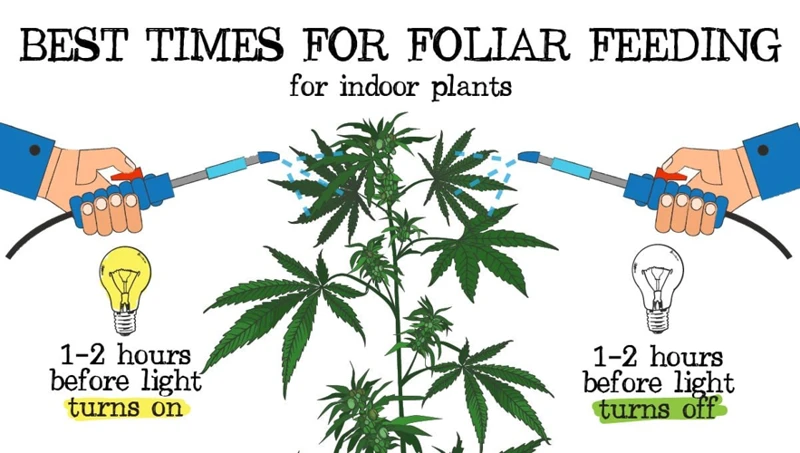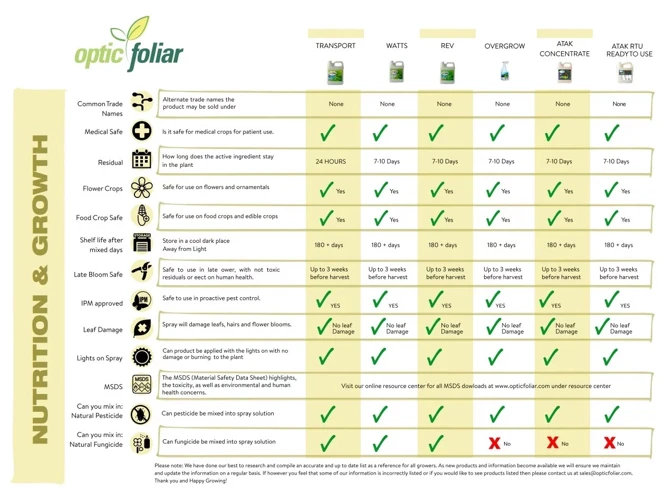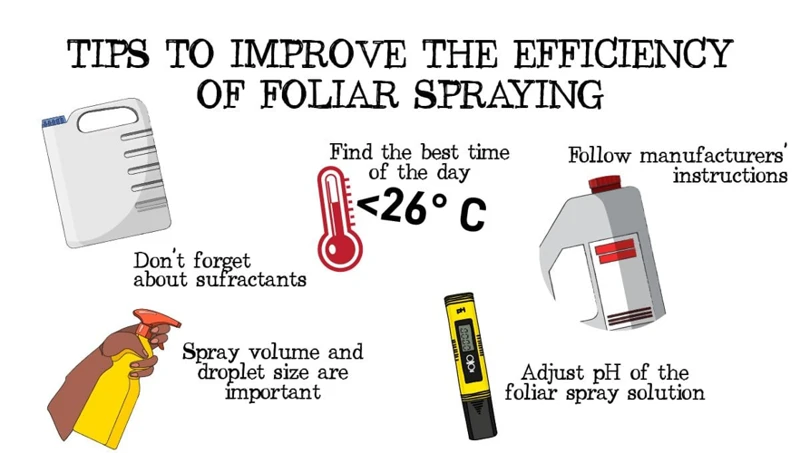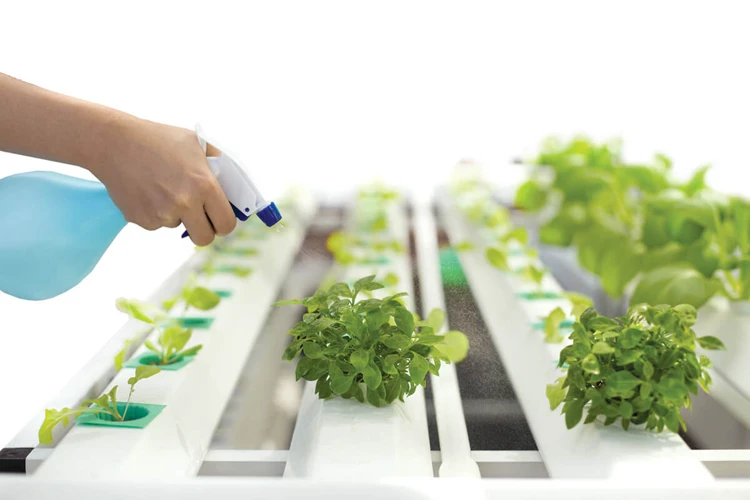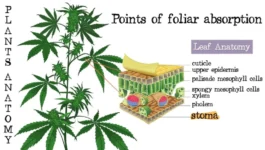
The Benefits of Foliar Feeding: Boosting Your Cannabis Growth
As a cannabis cultivator, you’re always on the lookout for ways to improve your plant’s growth and yield. If you’re stuck wondering how to get the most out of your crop, you might want to turn to the supplement method of foliar feeding. Foliar feeding involves applying liquid nutrients directly to the leaves of cannabis plants, and it comes with a wide range of benefits. In this guide, you’ll discover the advantages of foliar feeding, when to implement it, how to choose the right solution, and how to apply it correctly. By the end, you’ll have the knowledge you need to take your cannabis growth to the next level.
What is Foliar Feeding?
Contents
Have you ever heard of providing nutrients to your cannabis plant through its leaves? This alternative feeding method is called foliar feeding. Foliar feeding involves applying a nutrient-rich solution to the leaves of the plant to provide it with additional nutrients. While the traditional method of root feeding is still important, foliar feeding can be a valuable supplement to boost your plant’s growth and overall health. In this section, we will dive deeper into the concept of foliar feeding, discussing its importance and how it works. To learn more about organic vs synthetic nutrients for cannabis, click here. If you want to customize your feeding schedule for your cannabis strain, check out our guide here.
Why it’s important
Foliar feeding has become an essential practice among cannabis growers due to its numerous benefits. While traditional feeding methods involve applying nutrients to the soil, foliar feeding refers to the application of nutrients directly onto a plant’s leaves. This technique is highly effective and widely used because it allows quick absorption of nutrients and offers an excellent opportunity for growers to respond promptly to any nutrient deficiencies and other common issues such as pests and diseases.
Here are some reasons why foliar feeding is important:
- Increased nutrient uptake: Foliar feeding provides an efficient way of supplying nutrients to plants as it enables faster uptake of nutrients as compared to soil application. The stomata on the leaves absorb the fluids containing essential nutrients which are then transported throughout the plant for use in various metabolic processes. This feature allows plants to quickly recover from nutrient deficiency since they can quickly take up the necessary nutrients through their leaves.
- Improved plant health: When plants experience nutrient deficiencies, they become weak, susceptible to pests and diseases, and less productive. Foliar feeding can help overcome nutrient deficiencies and promote plant vigor. The nutrients applied through the leaves are readily available to the plant and can instantly improve the overall health and appearance of the crop.
- Shorter crop cycles: Foliar feeding accelerates crop growth by providing quick access to essential nutrients, which can shorten the plant’s life cycle from seedling to harvest. This approach enables farmers to reap faster rewards since the plant’s growth rate is accelerated.
With all these benefits, there is no doubt that foliar feeding is a crucial practice for any cannabis grower who wants to produce healthy and high-quality plants. However, it is essential to choose the right nutrients for the plant at the right time. Opting for organic nutrients or chemical nutrients can depend on grower preference, but understanding the nutritional requirements of the plants, the strain, and the stage of growth is essential for achieving the desired results. To learn more about organic vs synthetic nutrients in cannabis and how to create a custom feeding schedule for your cannabis strain, please visit our other articles: Organic vs Synthetic Nutrients in Cannabis and How to Create a Custom Feeding Schedule for Your Cannabis Strain.
How it works
Foliar feeding involves spraying a nutrient-rich solution directly onto the leaves of cannabis plants. This method is particularly effective because the leaves have small pores called stomata, which can easily absorb liquids. When sprayed onto the leaves, the nutrients are quickly absorbed by the plant and transported throughout the system.
So, how exactly does foliar feeding work?
Here are the steps involved:
- First, the nutrient solution is mixed in water to create a sprayable solution
- Next, the solution is sprayed onto the leaves, making sure to cover them evenly
- As the leaves absorb the solution, the nutrients are transported throughout the plant via the xylem and phloem
- Once the nutrients reach the roots, they are taken up into the plant and used for growth, development, and other metabolic processes
What are the benefits of this method?
One major advantage of foliar feeding is its ability to quickly deliver nutrients to the plant. This is especially important in cases of nutrient deficiencies or when a plant is undergoing stress. Foliar feeding can also increase the overall yield of the plant and improve its health, as nutrients are better utilized in this method. Additionally, foliar feeding is a cost-effective and efficient way to supplement the soil-based fertilization that is typically used in cannabis cultivation.
By following proper procedures and taking necessary precautions, cannabis growers can successfully implement foliar feeding as a vital step in their nutrient management plan.
The Benefits of Foliar Feeding for Cannabis Plants
As a cannabis grower, you know how important it is to provide your plants with the right nutrients to ensure optimal growth and yield. While soil nutrients and root feeding are crucial for overall plant health, foliar feeding can provide many additional benefits. When nutrients are applied directly to the leaves through foliar feeding, it can lead to quicker absorption and utilization, resulting in increased potency and yield. In this section, we will explore the various benefits of foliar feeding and how it can improve the health of your cannabis plants.
Quick absorption
Foliar feeding is known to have a quick absorption rate, making it an efficient method of delivering nutrients to cannabis plants. When nutrients are applied directly to the leaves, they can be rapidly taken up through the stomata and then translocated throughout the plant. This is especially beneficial when the plant is experiencing a nutrient deficiency or stress, which requires an immediate response.
Benefits of quick absorption:
- Fast delivery of nutrients to the plant
- Immediate response to nutrient deficiencies and stress
- Reduced risk of nutrient lockout or waste
- Increased efficiency and effectiveness of nutrient uptake
When using foliar feeding for quick absorption, it is important to choose the right type of fertilizer that is designed for this purpose. This will ensure that the nutrients are in a form that can be easily absorbed by the leaves and transported throughout the plant. Additionally, it is recommended to apply foliar feedings during the early morning or late afternoon when the stomata are more likely to be open, and the temperature is cooler, allowing for efficient nutrient uptake.
Increase in yield and potency
One of the most significant benefits of foliar feeding is the increased yield and potency of cannabis plants. By providing essential nutrients, minerals, and trace elements directly to the leaves of the plant, you can significantly improve the overall health and vitality of your cannabis crop.
Foliar feeding has been shown to increase the number and size of buds, resulting in a more bountiful harvest. Additionally, the nutrient-rich solution can help improve the potency of the buds by boosting their terpene and cannabinoid profiles.
When properly applied, foliar feeding can provide an additional source of nutrition for plants that may be experiencing nutrient deficiencies or other environmental stressors. In turn, this can help prevent stunted growth, yellowing leaves, and other signs of nutrient depletion.
The boosted yield and potency that come from foliar feeding can make a significant difference in the quality and quantity of your cannabis crop. By implementing a foliar feeding regimen alongside other best practices for cannabis cultivation, you can ensure that your plants thrive throughout their lifecycle, from seed to harvest.
Improved plant health
One of the major benefits of foliar feeding for cannabis plants is the improved plant health it provides. Here are some specific ways in which foliar feeding can help improve plant health:
- Stress tolerance: Foliar feeding can help improve a plant’s ability to handle stress, such as from extreme temperatures or drought conditions. This is because foliar feeding can provide the plant with the nutrients it needs to recover from stress more quickly.
- Resistance to disease and pests: When a plant is healthy and receiving the right nutrients, it is better able to resist disease and pests. Foliar feeding can help ensure that your cannabis plants have the nutrients they need to stay healthy and strong.
- Better nutrient uptake: Sometimes, even if the soil has plenty of nutrients, a plant may not be able to absorb them properly. This can happen if the soil pH is too high or too low, or if the plant’s root system is damaged. Foliar feeding can help deliver nutrients directly to the plant’s leaves, bypassing any absorption issues that may be present in the soil.
- Improvement in photosynthesis: Photosynthesis is the process by which plants convert light into energy. Foliar feeding can help improve photosynthesis by providing the plant with the nutrients it needs to create chlorophyll, which is necessary for photosynthesis to occur.
Improving plant health through foliar feeding can lead to overall healthier and more productive cannabis plants. By ensuring that your plants have the nutrients they need to thrive, you can help them reach their full potential in terms of yield, potency, and health.
When to Implement Foliar Feeding
As a cannabis grower, it’s important to know when your plants are in need of a nutrient boost. Foliar feeding can be an effective way to provide your plants with the necessary nutrients during key growth stages, as well as during periods of stress or nutrient deficiencies. Implementing foliar feeding at the right time can help your cannabis plants truly thrive. So, let’s take a closer look at when you should consider using foliar feeding for your cannabis crop.
During vegetative stage
The vegetative stage is a crucial period in the life cycle of cannabis plants. During this time, the plants are focused on developing their leaves, stems, and roots. This is the time when foliar feeding can provide the most benefit to cannabis plants.
Why use foliar feeding during vegetative stage?
Foliar feeding during the vegetative stage can provide the plants with the essential nutrients they need to grow strong and healthy. It can also help prevent nutrient deficiencies and increase the overall growth rate of the plants.
What nutrients are important during vegetative stage?
During the vegetative stage, cannabis plants require a balanced supply of nutrients, including nitrogen, phosphorus, and potassium. Nitrogen is essential for the growth of leaves and stems, while phosphorus is crucial for root development. Potassium is important for overall plant health and stress resistance.
How often to implement foliar feeding during vegetative stage?
Foliar feeding should be implemented once a week during the vegetative stage. The plants should be sprayed with a nutrient solution until they are fully saturated but not dripping.
What foliar feeding solution to use during vegetative stage?
During the vegetative stage, it is recommended to use a nutrient solution that has a higher nitrogen content compared to other nutrients. This will help the plants to grow larger and develop more foliage. A good option is a 20-10-10 fertilizer solution.
| Nutrient | Amount |
|---|---|
| Nitrogen | 20% |
| Phosphorus | 10% |
| Potassium | 10% |
What other factors to consider during vegetative stage?
During the vegetative stage, it is important to provide the plants with proper lighting, humidity, and air circulation. The temperature should also be kept between 70-85°F. Additionally, it is important to monitor the plants for signs of nutrient deficiencies, pests, and diseases.
With the right care and attention, cannabis plants in the vegetative stage can grow into strong and healthy plants that will produce ample yields during the flowering stage.
During flowering stage
During the flowering stage, foliar feeding can have a significant impact on the quality and yield of your cannabis plants. Here are some factors to consider:
- Nutrient requirements: During the flowering stage, cannabis plants require higher levels of phosphorus and potassium to support bud development and ripening.
- Application frequency: Foliar feeding should be done every 2-3 weeks during the flowering stage to ensure that your plants receive the necessary nutrients.
- Timing: It is best to foliar feed in the early morning or late afternoon when the sun isn’t too strong to avoid burn or wilting.
- Concentration: It is important to use a lower concentration of nutrients during the flowering stage to avoid excess buildup and nutrient burn.
- Product choice: Choose a foliar feeding solution that is specifically formulated for the flowering stage, as this will have the right balance of nutrients your plants need at this stage of their growth cycle.
By foliar feeding during the flowering stage, you can improve the overall health and vigor of your plants, leading to larger yields and better quality buds. Remember to monitor your plants regularly and adjust your feeding schedule and concentration accordingly to avoid any potential issues.
When facing nutrient deficiencies or stress
In addition to promoting growth and improving overall plant health, foliar feeding can also be incredibly helpful when plants are experiencing nutrient deficiencies or stress. When a plant is lacking in essential nutrients, it may not be able to absorb what it needs from the soil. In these cases, foliar feeding can provide a quick solution. However, it’s important to remember that foliar feeding should not be the primary way of delivering nutrients to your cannabis plants.
If you notice your plants developing yellow or brown spots on their leaves or if they are not growing as quickly as you would like, they may be experiencing nutrient deficiencies. Common deficiencies in cannabis plants include a lack of nitrogen, phosphorus, and potassium. Foliar feeding with a nutrient solution that targets the specific deficiency can help address the issue.
In addition to nutrient deficiencies, stress can also impact the growth and health of cannabis plants. Stress can come in many forms, such as changes in temperature or humidity levels, physical damage to the plant, or pest infestations. Foliar feeding can help to mitigate the effects of stress and promote recovery in these situations. However, it’s important to identify and address the source of the stress in order to prevent further damage to your plants.
Foliar feeding can be a valuable tool in helping cannabis plants overcome nutrient deficiencies and stress. Just remember to properly diagnose any issues and use foliar feeding as a supplemental method, rather than a primary source of nutrients.
Choosing the Right Foliar Feeding Solution
When it comes to foliar feeding, choosing the right solution can make all the difference in the health and growth of your cannabis plants. With so many options available, it can be overwhelming to determine which one is right for your particular needs. It’s important to consider factors such as whether you want an organic or chemical solution, the nutrient content, and the compatibility with your growing medium. In this section, we’ll explore how to choose the right foliar feeding solution for your cannabis plants.
Organic options
There are various organic options available to choose from when it comes to foliar feeding solutions for cannabis plants. Organic options are becoming increasingly popular among growers as they offer a more natural approach without harmful chemical additives. Here are some of the most common organic foliar feeding solutions:
- Compost Tea: Compost tea is essentially a liquid fertilizer that is made by steeping compost in water. It contains beneficial microorganisms that help promote healthy growth in plants. Compost tea can be applied either as a soil drench or a foliar spray.
- Seaweed Extract: Seaweed extract is a popular organic option for foliar feeding. It contains a range of beneficial plant hormones, vitamins, and minerals that can boost plant growth and health. Seaweed extract can be applied directly to the leaves and stem of the plant.
- Fish Emulsion: Fish emulsion is made from the byproducts of fish oil production. It is high in nitrogen, making it a great option for promoting leafy growth. Fish emulsion can be applied as a foliar spray or as a soil drench.
- Bone Meal: Bone meal is another popular organic option for foliar feeding. It is made from the ground-up bones of animals and is high in phosphorus, which is important for root development and flowering. Bone meal can be mixed with water and applied as a foliar spray.
When choosing an organic foliar feeding solution, it is important to read the labels carefully to ensure that the product is certified organic and free from harmful chemicals or additives that could harm your plants. It is also important to follow the manufacturer’s instructions for application rates and timing to ensure optimal results.
Chemical options
Chemical options for foliar feeding may be more effective for some growers as they can be tailored to suit the specific needs of their cannabis plant. However, it is important to note that chemical fertilizers can be harsh on the plant and the surrounding environment if not used carefully.
When choosing a chemical foliar feeding solution, it is important to look for one that is specially formulated for cannabis plants. These solutions will contain the correct ratios of nutrients needed for optimal growth and should include a balanced NPK ratio (Nitrogen, Phosphorus, and Potassium).
Here is a table of commonly used chemical foliar feeding options:
| Product Name | Chemical Composition | Benefits |
|---|---|---|
| Maxicrop Liquid Seaweed | N: 0.1% , P: 0.0% , K: 0.5%, micronutrients | Increases plant growth and overall health |
| BioBizz Bio-Heaven | N: 0.9%, P: 0.1%, K: 0.8%, micronutrients | Improves soil conditions and plant metabolism |
| General Hydroponics Floralicious Plus | N: 2.8%, P: 0.2%, K: 0.8%, micronutrients | Stimulates essential oil production and enhances flavors |
| Fox Farm Open Sesame | N: 5%, P: 45%, K: 0%, micronutrients | Encourages early flowering and fruit development |
It is also important to follow the instructions on the label and to start with a low concentration to avoid burning the plant. It is recommended to perform a test on a small part of the plant and wait a few days to observe the reaction before applying the foliar feeding solution to the entire plant.
Chemical options for foliar feeding can be an effective way to provide nutrients to cannabis plants, but it is important to use them with caution and to choose a solution specifically formulated for cannabis plants.
How to Apply Foliar Feeding
Once you have selected the right foliar feeding solution for your cannabis plants, the next step is to carefully apply it. Applying foliar feeding involves using specific equipment and following a step-by-step process to ensure that your plants receive the nutrients they need without causing any damage. In this section, we will discuss the necessary equipment and the best way to prepare and apply your foliar feeding solution. So, let’s dive into the process and explore the essential steps to ensure a healthy and robust cannabis crop.
Equipment needed
To apply foliar feeding to your cannabis plants, you will need a few pieces of equipment. Here is a list of what you will need:
- Spray bottles: You will need spray bottles to apply the foliar feeding solution to your plants. Make sure the spray bottle has a fine mist setting to ensure even coverage.
- Measuring cups or spoons: It is important to measure the foliar feeding solution accurately to avoid over or underfeeding your plants.
- Protective gear: Foliar feeding can cause irritation to the skin, eyes, and lungs, so it is important to wear protective gear such as gloves, goggles, and a mask.
- Clean water: You will need clean water to dilute the foliar feeding solution and to rinse the spray bottles and measuring tools between uses.
Having the right equipment is crucial for successful foliar feeding. Make sure to prepare all the necessary items before applying the foliar feeding solution to your plants. Remember to follow the instructions carefully to avoid overfeeding or causing damage to your plants.
Preparation and application
Before applying foliar feeding, you must make sure the plant is clean and free of dust and debris. The stomata, which are the small holes on the leaves that absorb the nutrients, need to be open and clear for proper absorption. Here are the steps to follow for proper preparation and application of foliar feeding:
Step 1: Dilution
Dilute the foliar feeding solution according to the instructions on the package. It’s critical not to overdo the dilution because it may harm your plant.
Step 2: Equipment
Choose the best equipment for spraying the solution. A handheld sprayer or pressure sprayer with a fine mist nozzle is ideal for distributing the solution evenly on the leaves. The nozzle should be adjusted so that it produces small droplets without damaging the leaves.
Step 3: Timing
The best time to apply foliar feeding is early in the morning or in the evening, when the temperatures are cooler but not when the lights are out. Adequate light encourages the stomata to stay open, allowing for better absorption of the nutrients.
Step 4: Application
Begin applying the solution slowly and steadily to the plants, starting from the bottom and working your way up to the top. Make sure to spray both sides of each leaf until they are completely covered.
Step 5: Drying
Allow the solution to dry on the leaves naturally. Avoid using fans or other means of drying the solution as it may cause the leaves to burn.
Step 6: Clean-Up
After application, clean the equipment thoroughly, and store it in a safe place. Also, ensure that the remaining solution is disposed of safely and correctly.
By following these steps, you ensure the proper preparation and application of foliar feeding on your cannabis plants, leading to improved growth and health.
Precautions to Take when Foliar Feeding
While foliar feeding can be an effective way to give your cannabis plants a nutrient boost, it’s essential to take certain precautions to ensure its success. Without proper precautions, you risk burning your plant, damaging it, or spreading pests and diseases. In this section, we’ll outline some important measures to take to prevent these issues and keep your plants healthy. Let’s deep dive into the precautions you should take when foliar feeding your cannabis plants.
Overuse and burn
Overuse and burn are common issues that can occur when foliar feeding cannabis plants. It is important to follow proper application guidelines to avoid causing damage to the plants.
Overuse
Overuse of foliar feeding solutions can result in an excess buildup of nutrients, which can lead to toxicity and nutrient lockout. This can cause the plants to become stunted, discolored, and even die. It is important to only apply the recommended amount of solution and to avoid frequent foliar feeding.
Burn
Foliar feeding solutions can also cause burn if they are applied in high intensity light or when the temperature is too high. Burn is characterized by scorched, brown patches on the leaves. To prevent burn, foliar feed during the cooler parts of the day and avoid direct light exposure for a few hours after application.
To avoid overuse and burn, carefully monitor the plants after each application of foliar feeding solution. Look for symptoms of toxicity or burn, such as yellowing or browning of the leaves. If you notice any signs of damage, stop foliar feeding and adjust your application method. Remember, foliar feeding should be a supplement to regular feeding and not a replacement.
Contamination and pests
When it comes to foliar feeding, contamination and pests can be a potential issue that needs to be addressed to ensure the health of your cannabis plants. Here are some measures you can take to avoid contamination and pests during foliar feeding:
- Clean equipment: Make sure all equipment used for foliar feeding, such as spray bottles, is clean and free of residues or prior pesticides. Clean equipment thoroughly after each use and store it in a clean, dry place to avoid contamination.
- Use clean water: The water used for foliar feeding should be clean and free of any contaminants or impurities. Using tap water may contain chlorine or other chemicals that could be harmful to plants. Consider using distilled or purified water for best results.
- Choose the right timing: Foliar feeding should not be done during peak sunlight hours as the solution can act as a magnifying glass, potentially burning the leaves. Instead, foliar feed early in the morning or later in the evening when the sun is not as intense.
- Use proper concentration: It’s important to follow the recommended concentration of the foliar feeding solution to avoid overuse or underuse. Overuse can cause the solution to accumulate on leaves, leading to toxicity and potential pest issues. Underuse may not provide the necessary nutrients for the plants.
- Monitor for pests: Foliar feeding can attract pests, particularly if the solution contains sugars or other attractants. Monitor your plants for any signs of pest activity, such as holes or webbing on leaves, and take appropriate measures to eliminate them.
By taking these precautions, you can minimize the risk of contamination and pests during foliar feeding, ensuring that your cannabis plants receive the nutrients they need to thrive.
Frequently Asked Questions
As with any new technique or approach, foliar feeding for cannabis plants can raise many questions and uncertainties. It’s completely normal to be curious about the safety, effectiveness, and best practices for foliar feeding, especially when it comes to something as valuable as your cannabis crop. To help alleviate any doubts or concerns you may have, we’ve compiled some of the most frequently asked questions about foliar feeding and provided detailed answers and explanations. So, let’s dive in and clear up any confusion about this beneficial method!
Is foliar feeding safe for cannabis?
When it comes to foliar feeding cannabis, one of the most common questions is whether or not it is safe. The truth is, foliar feeding can be a safe and effective way to give your plants the nutrients they need to thrive. However, it is important to take certain precautions to ensure that your plants are not harmed in the process.
Here are some potential risks and benefits of foliar feeding cannabis:
| Risks | Benefits |
|---|---|
| Using too much fertilizer can cause burn and damage to the leaves. | Foliar feeding can provide a quick and efficient way to deliver nutrients and correct nutrient deficiencies in your plants. |
| Applying foliar sprays during the wrong time of day can lead to moisture buildup and promote fungal growth. | Foliar feeding has the potential to increase yield and potency and improve overall plant health. |
| Using contaminated equipment can introduce harmful pests and diseases to your plants. | Foliar feeding can be particularly useful during times of nutrient deficiencies or stress, such as periods of high heat or drought. |
Foliar feeding can be a safe and beneficial practice for cannabis growers. However, it is important to take precautions such as using the appropriate amount of fertilizer, applying sprays at the right time of day, and ensuring that equipment is clean and free of pests and diseases. By following these guidelines, you can help ensure that your plants receive the nutrients they need to thrive without any negative side effects.
Can I use regular fertilizer for foliar feeding?
When it comes to foliar feeding, using regular fertilizer may not be the best option. While regular fertilizer is designed to provide nutrients to the plant, it is not formulated to be applied as a foliar spray.
Regular fertilizers are designed to be applied to the soil so that the roots can absorb the nutrients. When using these fertilizers as a foliar spray, some of the nutrients may not be absorbed by the leaves and could be wasted. Additionally, using regular fertilizer as a foliar spray can increase the risk of leaf burn and damage.
Instead of using regular fertilizer, it’s recommended to use a specific foliar feeding solution. These solutions are specially formulated to be applied as a foliar spray and provide the necessary nutrients that the plant needs for optimal growth.
Foliar feeding solutions are designed to be quickly absorbed by the leaves, meaning that the plant can access the nutrients immediately. This can lead to faster growth and improved plant health. Additionally, because the nutrients are being directly absorbed by the leaves, there is less risk of nutrient waste or leaf burn.
While regular fertilizer may seem like a convenient option for foliar feeding, it is not recommended. Instead, invest in a specific foliar feeding solution to ensure optimal growth and plant health.
| Regular Fertilizer | Specific Foliar Feeding Solution |
|---|---|
| Not formulated for foliar spray | Specially designed for foliar application |
| Increase risk of leaf burn and damage | Less risk of nutrient waste or leaf burn |
| Some nutrients may not be absorbed by leaves | Quick absorption by leaves for faster growth |
What time of day is best for foliar feeding?
When it comes to foliar feeding, the best time of day to apply the solution is early in the morning or late in the afternoon. This is because during these times, the temperature is cooler and the humidity is higher, allowing the solution to last longer on the leaves and giving the plant time to absorb as much of it as possible before it evaporates.
Here are some key points to keep in mind:
- Do not apply the solution in direct sunlight or during the hottest part of the day as this can cause the leaves to burn.
- It is also not recommended to apply the solution at night as the plants are in a dormant state and the solution may not be as effective.
- Additionally, make sure to check the weather forecast before applying foliar feeding solution, as windy or rainy conditions can also reduce its effectiveness.
- It is important to be mindful of the weather conditions and timing in order to optimize the benefits of foliar feeding for your cannabis plants.
Remember, foliar feeding can be a great way to boost your cannabis growth, but it is important to follow proper techniques and precautions to ensure the best results.
Conclusion
In conclusion, foliar feeding is an effective and efficient method of providing your cannabis plants with the necessary nutrients they need for healthy growth, increased yield, and potency. By directly applying the nutrient solution to the leaves of the plants, you can ensure that they are rapidly absorbed and utilized by the plant’s systems. This approach can help save time and money compared to traditional methods of fertilization, while also allowing for more targeted and precise doses of nutrients.
However, it’s important to choose the right foliar feeding solution and apply it correctly to avoid causing any harm to your plants. It’s also crucial to time your foliar feedings according to your plant’s growth stage and any nutrient deficiencies or stress it may be experiencing.
By taking the necessary precautions and being consistent with your foliar feeding routine, you can enjoy the many benefits of this technique and bring your cannabis plants to their full potential. So give foliar feeding a try and see the positive results for yourself!
Frequently Asked Questions
Yes, foliar feeding is safe for cannabis if done properly and with the right solutions.
No, regular fertilizer is not suitable for foliar feeding as its concentration is too high and can burn the plant leaves. Use a specifically designed foliar feeding solution instead.
It’s best to foliar feed either early in the morning or late in the evening, when the temperature is cooler and the sun is not as strong.
What equipment do I need for foliar feeding?
You will need a spray bottle or a backpack sprayer to apply the foliar feeding solution, as well as protective gear like gloves and goggles.
How often should I foliar feed my cannabis plants?
This depends on the specific foliar feeding solution and the stage of growth of your cannabis plants. Read the instructions on the solution carefully and follow the recommended application frequency.
Can foliar feeding replace soil nutrients?
No, foliar feeding is meant to supplement soil nutrients, not replace them.
Can I mix different foliar feeding solutions together?
No, it’s not recommended to mix different foliar feeding solutions together as it can result in unpredictable results and damage the plants.
Can foliar feeding be used in hydroponics?
Yes, foliar feeding can be used in hydroponics, but it’s important to choose a solution that is specifically formulated for hydroponic growing systems.
What if I accidentally sprayed too much foliar feeding solution?
If you accidentally sprayed too much foliar feeding solution, you risk burning the leaves and damaging the plant. Rinse the leaves off immediately with water and reduce the amount of solution you use in the future.
Can foliar feeding be used in conjunction with other nutrient delivery methods?
Yes, foliar feeding can be used in conjunction with other nutrient delivery methods, but it’s important to monitor the plant’s growth and adjust the amount of nutrients accordingly to avoid overfeeding or nutrient burn.

